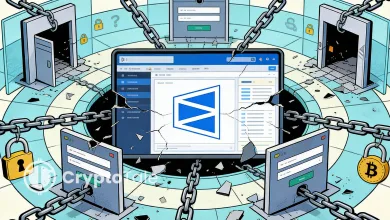XRP Faces Pressure as Descending Triangle Shapes Market Outlook

- XRP forms a descending triangle pattern, signalling potential downside market pressure.
- Technicals show weakening momentum, with $2.53 as the next key downside target to watch.
- Institutional adoption grows, but short-term resistance stalls price despite rising activity.
XRP is fighting to hold ground above $3 after recent volatility pushed the token into a fragile technical structure. On lower timeframes, bulls defended $2.70 with strength, sparking a rebound toward resistance at $3.10. Yet on the broader chart, XRP continues to trade within a descending triangle, a pattern often tied to bearish outcomes.
This contradiction between the short-term recoveries and the long-run instability indicates the role of market psychology in determining the price of XRP. Every rally encounters resistance with the sellers putting pressure to move out. The outcome is a series of lower highs pushing the price down to support, narrowing the triangle.
Bearish Indicators Gain Momentum
XRP trades below its 50-day and 100-day simple moving averages. Analysts now warn that the 200-day moving average near $2.53 is the next major test. Losing that level would confirm sustained downside pressure.
The relative strength index (RSI) is still in a downward trend. This fall is an indication of weakening momentum, with the buyers struggling to create sustained follow-through. When RSI aligns with a descending triangle, history shows price often breaks lower.

Source: Tradingview
The net unrealised profit/loss (NUPL) metric adds another dimension. XRP holders are sitting on high levels of unrealised gains, increasing the risk of profit-taking. Historically, NUPL spikes have coincided with corrections as traders lock in profits.
The 2017 and 2021 bull markets are recent illustrations where XRP experienced an extensive pullback after peaking. The same was seen in early 2025 as high NUPL levels were followed by another correction. The current setup is similar to those stages, where overextended profits and technical vulnerability lead to retreats.
Historical Comparisons and Market Psychology
Descending triangles, in many instances, represent trader psychology in distribution phases. Buyers anticipate rebounds in the support areas, whereas sellers use rallies to reduce exposure. This price war tightens the price, and a decisive move comes thereafter.
XRP’s current structure resembles prior corrections where prolonged consolidation broke lower before recovery resumed. In 2017, XRP corrected sharply after forming a similar triangle. A comparable scenario unfolded in 2021, with the token falling before regaining strength months later.
Analysts, including Ali, now point to the $2.70 zone as the critical level. Holding this support could spark another attempt at $3.60 or higher. Failure, however, may open the path toward $2.53, where the 200-day moving average sits.
The coming weeks will test whether XRP can overcome converging pressures. Market psychology, profit-taking, and bearish technical patterns remain aligned. Unless bulls reclaim $2.99 and close above resistance, XRP risks another correction.
Related: XRP and Dogecoin ETFs Debut With Record Trading Volumes
Trading Activity and Institutional Context
The number of transactions completed on XRP Ledger in a single day exceeded one million on September 22, which highlights high levels of ecosystem activity. Active accounts and network activity also climbed, reflecting increased usage. Despite this, price action did not capitalize, indicating how on-chain adoption is not necessarily correlated with short-term performance.
Developments in institutions are also significant. Ripple added a collaboration with DBS and Franklin Templeton, allowing trading of funds on the XRPL. The inclusion of RLUSD, a stablecoin provided by Ripple, into the program also enhances infrastructure in enterprise use. These moves enhance long-term credibility, though near-term charts remain bearish.
The launch of a spot XRP ETF also added liquidity. The trading volume also spiked following the listing, indicating the presence of investor interest. However, XRP could not overcome the resistance levels even with the ETF tailwind, reinforcing the weight of technical barriers.
Market data shows that 67% of XRP transactions are now a result of trading and swaps, similar to other high-volume chains. The trend increases the significance of transaction costs and market positioning, with traders acting fast to technical breakdowns.




